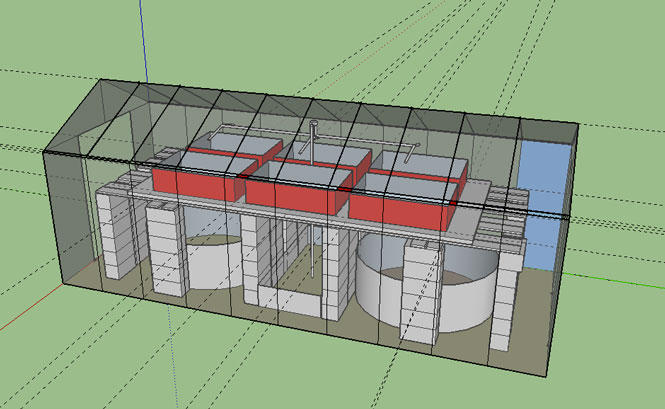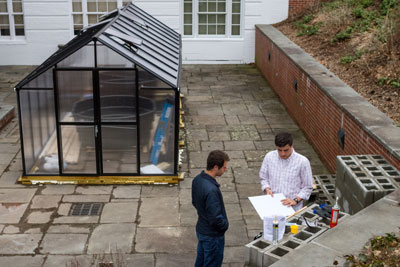
Right outside of Amherst College’s dining hall, a new student club is exploring what just might be the future of food.
This spring, the Hooked on Aquaponics club has been constructing a greenhouse outside of Valentine Dining Hall. Their ultimate goal is to have a self-sustaining, soil-free aquaponics operation raising fish and plants.
Aquaponics combines aquaculture (farming of aquatic animals) with hydroponics (growing plants without soil). The greenhouse setup collects waste from the fish and converts it into plant food.
The project began as a collaborative effort, with individual aspects drawn from the interests of founding members Peter Suechting ’15, Jim Hall ’15, Thais Correia ’16 and Eli Mansbach ’18. Hooked on Aquaponics now boasts about 10 core members and attracts twice that at meetings.
“We have a very strong base of underclassmen,” said Hall. “When it comes to building projects, everyone wants to get involved, even people who aren’t official members.”
Correia is a computer science major who’s taken several environmental studies classes. She’s interested in how technology can be used for the betterment of the Earth’s health. “I thought this was a cool way to do something on campus and work on both of these interests,” she said. She and Henry Laney ’17 have assembled an electronic system that keeps the moving parts of the greenhouse running and collects data on pH, temperature and more. Suechting's involvement comes from his original plan to build a greenhouse as part of his environmental studies senior thesis.
The greenhouse, funded by the Office of the President, contains two 300-gallon fish tanks, which drain into a filtered tank. The water will then be pumped into six tubs containing plants and bacteria which assist in converting the fish waste into usable fertilizer.
“Once the water reaches a certain level, it gets dumped back into the [fish] tank,” said Correia. “By this point it’s been mostly filtered out by the plants themselves … so the only water that we lose is through evaporation.”
In theory, hydroponic systems conserve 90 percent more water than traditional agricultural methods, and aquaponic systems, in turn, conserve 90 percent more than hydroponics. Depending on the plant, aquaponics can make it possible to grow twice as many plants per square foot as in traditional agriculture.
“You can grow it year-round. You can produce more in less space using fewer resources,” Hall said.

The club is starting with 200 baby koi, being fed fish food as the operation gets going. Future plans include raising edible fish such as tilapia, carp or bass, Suechting said.
The group hopes to sell the produce and fish to Valentine Dining Hall, especially during the winter, when the campus’s Book & Plow Farm doesn’t operate. “We wouldn't be able to provide the whole school with enough fish, but it could supplement,” Suechting said. “Things grow a lot faster in these types of systems, and it’s easier for us to switch between different types of plants.”
The implications for a hungry planet are significant if this technology can be implemented on a large scale, students said. Abandoned buildings could be converted into greenhouses, bringing fresh, organic produce and jobs back to urban dead zones. As produce could be made year-round potentially anywhere, there would be no transportation costs.
Hooked on Aquaponics intends to pass the campus greenhouse down from class to class. As it involves a potentially wide array of technologies and species, the club’s founders are optimistic that the greenhouse can thrive and evolve.
“I hope that every year people just keep adding more and more complexity to the system, and eventually we can get a bigger greenhouse,” said Correia. “This is just the beginning.”